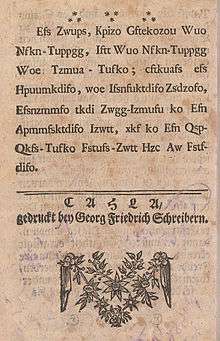Hermann Fictuld

Hermann Fictuld (ca.14 Jan 1700 - ca.1777) was a pseudonym used by an early Freemason, whose identity has not been definitely determined. [1] He wrote books on alchemy and on Hermeticism.[2][3][4]
In addition to other works on alchemy,[2] Fictuld published Der Längst gewünschte und versprochene chymisch-philosophische Probier-Stein, auf welchem sowohl der wahrhafften hermetischen Adeptorum als der verführischen und betriegerischen Sophisten Schrifften sind probirt und nach deren Werth dargestellt worden, beschrieben in zweyen Classen (1753), an annotated bibliography of alchemical writings. In the second edition Fictuld distinguishes between those he considers true adepts and sophists or charlatans. He criticized the works of alchemists such as DJW (Dorothea Juliana Wallich) with "great severity", castigating them as fit only for burning.[5]
Hermann Fictuld was one of the leaders of the Order of the Golden and Rosy Cross, whose origins he traced to the Order of the Golden Fleece.[3] The Golden and Rosy Cross was first written about by Samuel Richter ('Sincerus Rinatus') in Breslau in 1710. Fictuld led an extensive reform in the organization in the 1760s and 1770s. Fictuld's Aureum Vellus oder Goldenes Vliess (1749) may have offered a common foundation which appealed to a variety of existing Hermetic groups.[6] Fictuld corresponded with theosopher Friedrich Christoph Oetinger.[7] In his recreation of the Order, Fictuld sought a return to "old ways and ceremonies" representing the "veneration of God and the welfare of humankind."[7] The Aureum Vellus was widely read and may have led to the Order's integration into the Society of Freemasons.[6]

Some believe that Hermann Fictuld's real identity was Baron Johann Friedrich von Meinstorff,[5][8] based on a substitution cipher at the end of one of his books, p. 380 of Azoth et Ignis, Das ist, das wahre Elementarische Wasser und Feuer Oder Mercurius Philosophorum, Als das einige nothwendige der Fundamental-Uranfänge und Principiorum des Steins der Weisen, 1749. Other sources suggest that his real name may have been Johann Heinrich Schmidt von Sonnenberg (1700-1777).[9]
| Library resources about Hermann Fictuld |
| By Hermann Fictuld |
|---|
References
- ↑ Hanegraaff, Wouter J.; Faivre, Antoine; Broek, Roelof van den; Brach, Jean-Pierre (2005). Dictionary of gnosis and western esotericism (Online ed.). Leiden: Brill. ISBN 9789004141872. Retrieved 6 May 2015.
- 1 2 Faivre, Antoine (1994). Access to Western esotericism. Albany, NY: State Univ. of New York Press. pp. 178–186. ISBN 9780791421789. Retrieved 6 May 2015.
- 1 2 Schuchard, Marsha Keith (2012). Emanuel Swedenborg, secret agent on Earth and in heaven : Jacobites, Jews, and Freemasons in early modern Sweden. Leiden: Brill. pp. 482–483. ISBN 9789004183124.
- ↑ Churton, Tobias (2009). The invisible history of the Rosicrucians : the world's most mysterious secret society. Rochester, Vt.: Inner Traditions. pp. 396–398. ISBN 9781594772559.
- 1 2 Macrakis, Kristie (2014). Prisoners, lovers, & spies : the story of invisible ink from Herodotus to al-Qaeda. New Haven: Yale University Press. ISBN 9780300179255.
- 1 2 Faggionato, Raffaella (2005). A rosicrucian utopia in eighteenth-century Russia : the Masonic Circle of N.I. Novikov. Dordrecht: Springer. p. 69. ISBN 978-1-4020-3486-2.
- 1 2 McIntosh, Christopher (2012). The Rose Cross and the Age of Reason Eighteenth-century Rosicrucianism in Central Europe and Its Relationship to the Enlightenment. (Second ed.). Albany: State Univ of New York Pr. ISBN 978-1438435602.
- ↑ Schmidt, Johann Wilhelm (1803). Maurerisches Taschenbuch auf das Jahr: 5803 bis 5804 von X.Y.Z. Berlin. p. 46. Retrieved 7 May 2015.
- ↑ Soukup, Rudolf W. (2007). Chemie in Österreich : von den Anfängen bis zum Ende des 18. Jahrhunderts ; Bergbau, Alchemie und frühe Chemie ; Geschichte der frühen chemischen Technologie und Alchemie des ostalpinen Raumes unter Berücksichtigung von Entwicklungen in angrenzenden Regionen. Wien: Böhlau. ISBN 9783205775676. Retrieved 7 May 2015.